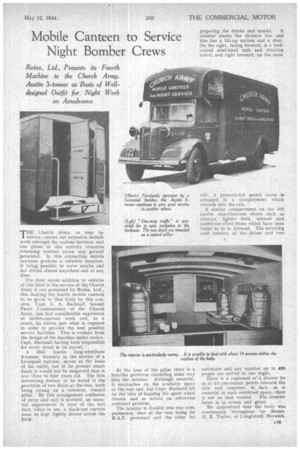Mobile Canteen to Service Night Bomber Crews
Page 21

If you've noticed an error in this article please click here to report it so we can fix it.
Rotax, Ltd., Presents its Fourth Machine to the Church Army. Austin 3-tonner as Basis of Welldesigned Outfit for Night Work on Aerodromes
THE Church Army, as may be known, carries out extensive welfah work amongst the various Services, and one phase of this activity concerns returning bomber crews and ground personnel. In this connection mobile canteens perform a valuable function, it being possible to serve snacks and hot drinks almost anywhere and at any time.
The most recent addition to vehicles of this kind in the service of the Church Army is one presented by Roth, Ltd., this making the fourth mobile canteen to be given to that body by this concern. Capt. G. A. Bucknall, Second Front Commissioner of the Church Army, has had considerable experience of mobile-canteen work and, as a result, he knows just what is required in order to provide the best possible service facilities. This is evident from the design of the machine under review, Capt. Bucknall having been responsible for every detail in its layout.
A 1941 Austin long-wheelbase 3-tonner, formerly in the service of a Liverpool butcher, serves as the basis of the outfit, but in its present smart finish it would mat be suspected that it was three to four years old. The first interesting feature to be noted is the provision of two doors at the rear, both being swung on a common, central pillar. By this arrangement confusion of entry and exit is avoided, an essential requirement in view of the fact that, vs-hen in use, a black-out curtain must be kept tightly drawn across the back. At the base of the pillar there is a box-like partition extending some way into the interior. Although essential, it encroaches on the available space at the rear end, but Capt. Bucknall hit on the idea of housing the spare wheel therein and so solved an otherwise wkward problem. The interior is divided into two compartments, that at the rear being for R.A.F. personnel and the other for preparing the drinks and snacks. A counter marks the division line and this has a lift-up section and a door. On the right, facing forward, is a lead. coated steel-lined sink and draining board, and right forward, on the same side, a pressure-fed petrol stove is arranged in a compartment which extends into the cab.
A similar compartment on the left carries miscellaneous stores such as tobacco, lighter' fluid, mirrors and numerous other items which have been found to be in demand. The servicilig staff consists of the driver and two assistants and any number up to 450 . people are served in one night. • There is a cupboard or a drawer let in at all convenient points beneath the sink and counters; in fact, as is essential in such restricted space, there is not an inch wasted. The interior finish is in cream and green. We understand that the body was constructed throughout by Messrs. 11.E. Taylor, of Cringleford, Norwich. <




















































